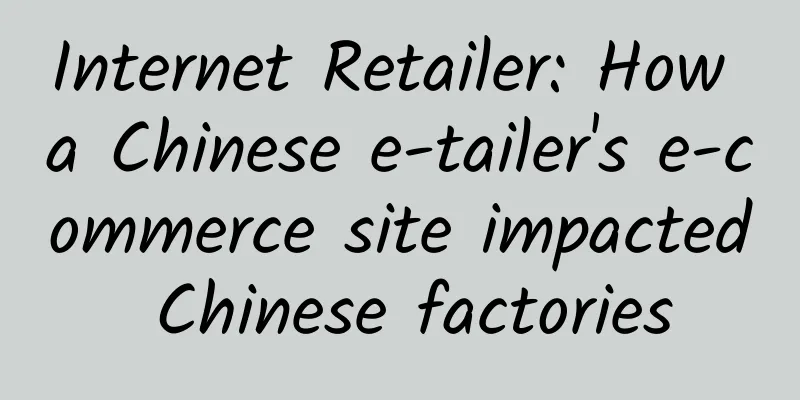Internet Retailer: How a Chinese e-tailer's e-commerce site impacted Chinese factories

|
Internet Retailer, an authoritative American e-commerce magazine, recently reported on the cross-border e-commerce company LightInTheBox with the title “How a Chinese e-retailer influences Chinese factories”. Compiles like this: Guo Quji often tells his employees not to think of LightInTheBox.com as a local company but as a global enterprise that originated in China. The e-commerce company aims to seize the fast-changing Internet development trend, use China's huge production base to produce popular goods at low prices, and sell them to online shoppers around the world through the Internet. In the view of Guo Quji, chairman and CEO of LightInTheBox, the era of China's low-cost mass production is over. Instead, retailers in Beijing usually place small orders with factories to respond to consumers' changing preferences at any time. "We fulfill small orders directly from many Chinese factories, so we can offer consumers a wide variety of goods and often customized services," said Guo Quji, who was a senior executive at Google and Amazon before founding LightInTheBox in 2007. LightInTheBox has its own proprietary technology that aims to discover shopping trends that others haven’t yet realized. “The web crawler we developed can crawl a large number of websites and find signals on social media to determine what kind of products will be attractive to people at a specific time and in a specific area,” said Guo Quji. The technology helped LightInTheBox notice a growing demand for LED faucets five years ago. These faucets change color with the water temperature, and "they became a best-seller," Guo said. Although other e-commerce companies also sell these LED faucets, LightInTheBox still tops Google's organic and paid results today. In order to cope with the changes in demand, Guo Quji had to persuade Chinese factories to produce some products with newer styles and smaller minimum order quantities based on customer needs. “When we ordered faucets from manufacturers, they kept telling us that the minimum order quantity was 5,000 or 10,000 items,” Guo recalled. “I asked them why, and they said the molds were very expensive. Why were the molds so expensive? They said, because they needed the molds to make at least 10,000 items.” Guo said he had persuaded the factory to produce molds that could only make 100 products. These molds were cheaper, and he could test new products. "Nowadays, people want more variety in goods, and their tastes change very quickly," Guo said. "Compared with scale and cheapness, flexibility is becoming more and more important." From the beginning, Guo's idea was to sell Chinese-made goods, such as wedding dresses and formal wear, overseas because Chinese factories can produce custom goods at a lower cost. Although LightInTheBox has a Chinese website for domestic consumers, the company generated 62.5% of its revenue in 2013 from Europe and 18.8% from North America. LightInTheBox's main e-commerce sites, LightInTheBox.com, which sells clothing and home goods, and MiniInTheBox.com, which sells electronics and tools, are translated into 27 languages. Not only the website and product descriptions, but also customer service and marketing are performed by native-speaking staff, Guo said. In Guo Quji's eyes, global vision is a very important strategy for Lightinthebox, which allows him to sell a lot of long-tail products. In any single regional market, these products may not generate enough market demand and profits, so traditional stores will not purchase and sell them. "These long-tail products will not have a large market in a single region, so it is very difficult to sell them offline." He said, "However, if we aggregate long-tail demand globally, we can make these products have outstanding commercial value." Guo Quji said that by the end of 2013, LightInTheBox had 1,426 employees, some of whom were Chinese graduates with foreign language skills and some were expatriates working in China, who provided services to consumers all over the world. In addition, they also added some part-time staff who mainly lived in Europe, who would continue to provide localized services after the full-time employees got off work. LightInTheBox has grown rapidly, with revenue increasing from $26.1 million in 2009 to $292.4 million in 2013. It has 4.29 million users, and one-third of its sales come from repeat customers. Based on its optimistic outlook for the future, LightInTheBox raised its second-quarter revenue forecast from $84 million to $86 million to $86 million, which means the company's quarterly revenue will increase by 20% year-on-year. Looking ahead, Guo sees other online retailers — including Amazon and British clothing retailer ASOS — opening no physical stores in more and more countries, just as LightInTheBox has done. "This is a rare thing and a new trend. But I expect that in 10 or 20 years, this will become the default option for any e-commerce company," Guo said. "We started cross-border e-commerce very early, and I am very optimistic about the future. We are in a unique position. We are a pioneer in this industry and one of the few listed companies. We have global genes and understand the Internet and supply chain. We can take advantage of China's cost advantages and have talent pools in the United States and other countries." Guo Quji said that's why he told his employees not to think of LightInTheBox as a Chinese company. Company Profile: Founded in 2007, LightInTheBox is an e-commerce company that operates LightInTheBox.com, a well-known international trade website in China. The company has more than 800 employees in Beijing, Shanghai, Suzhou and Shenzhen. |
>>: In 2013, the total market value of China's tourism industry was nearly 400 billion yuan.
Recommend
Does Huangbo harm the kidneys?
Huangbo is a very common medicine in life. It can...
The efficacy and function of chicken bone changshan
The medical value of Chicken Bone Changshan is be...
The efficacy and function of plum gum
Traditional Chinese medicine often has unexpected...
The efficacy and function of the nine-scented insect [picture]
Nine-scented insect [picture] is a kind of tradit...
Ammonia treatment administrator: Why can this battery save fish lives?
Author: Duan Yuechu Ammonia is a toxic compound t...
The efficacy and function of pear wood ash
Speaking of pear wood ash, we are all familiar wi...
How did Dacron, which was popular all over the country in the 1970s and 1980s, promote the "clothing revolution" among Chinese people?
I wonder how many people still remember "Dac...
What is the effect of Tianxiancao
When people encounter diseases, they now prefer t...
The efficacy and function of Chinese medicine red yeast rice
I have always thought that red yeast rice was a s...
Playing in the snow for a long time can lead to this disease? Learn more about "snow blindness"
Reviewer of this article: Xu Qibin, associate chi...
Universe-level production! Astronauts shoot "space station blockbuster" in orbit, how is it shot?
Produced by: Science Popularization China Author:...
The efficacy and function of bamboo forest
The environment is now seriously deteriorating an...
China's "first long text goblet" was unearthed in Yunmeng, Hubei!
In September 2020, the Hubei Provincial Institute...









